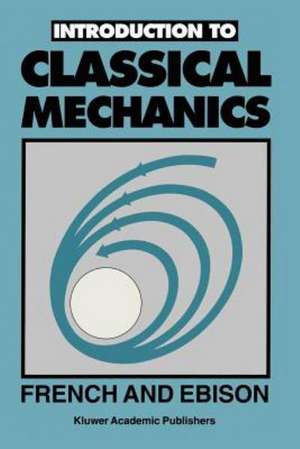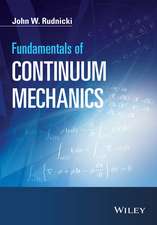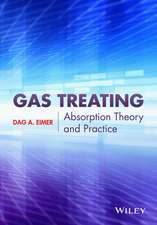Introduction to CLASSICAL MECHANICS
Autor A.J. French, M.G. Ebisonen Limba Engleză Paperback – 31 aug 1986
Preț: 699.74 lei
Preț vechi: 823.22 lei
-15% Nou
Puncte Express: 1050
Preț estimativ în valută:
133.91€ • 139.01$ • 111.66£
133.91€ • 139.01$ • 111.66£
Carte tipărită la comandă
Livrare economică 24 martie-07 aprilie
Preluare comenzi: 021 569.72.76
Specificații
ISBN-13: 9780412381409
ISBN-10: 0412381400
Pagini: 320
Ilustrații: 320 p. 188 illus.
Dimensiuni: 155 x 235 x 17 mm
Greutate: 0.5 kg
Ediția:Softcover reprint of the original 1st ed. 1986
Editura: SPRINGER NETHERLANDS
Colecția Springer
Locul publicării:Dordrecht, Netherlands
ISBN-10: 0412381400
Pagini: 320
Ilustrații: 320 p. 188 illus.
Dimensiuni: 155 x 235 x 17 mm
Greutate: 0.5 kg
Ediția:Softcover reprint of the original 1st ed. 1986
Editura: SPRINGER NETHERLANDS
Colecția Springer
Locul publicării:Dordrecht, Netherlands
Public țintă
ResearchCuprins
1 Space, time and motion.- What is motion?.- Frames of reference.- Coordinate systems.- Combination of vector displacements.- Scalar product of vectors.- Units and standards of length and time.- Velocity.- Relative velocity and relative motion.- Acceleration.- Straight-line motion.- Uniform circular motion.- Velocity and acceleration in polar coordinates.- Problems.- 2 Forces.- Forces in equilibrium.- Action and reaction in the contact of objects.- Rotational equilbrium: torque.- Inertia.- Force and inertial mass: Newton’s second law.- Some comments on Newton’s second law.- The invariance of Newton’s second law; relativity.- Concluding remarks.- Problems.- 3 Using Newton’s laws.- Some examples of F = ma.- Circular paths of charged particles in uniform magnetic fields.- The fracture of rapidly rotating objects.- Motion against resistive forces.- Detailed analysis of resisted motion.- Motion governed by viscosity.- Growth and decay of resisted motion.- Simple harmonic motion.- Problems.-4 Universal gravitation.- The discovery of universal gravitation.- Kepler’s third law.- The moon and the apple.- The gravitational attraction of a large sphere.- Other satellites of the earth.- The value of G, and the mass of the earth.- Local variations of g.- Inertial and gravitational mass.- Weight.- Weightlessness.- The discovery of Neptune.- Gravitation outside the solar system.- Einstein’s theory of gravitation.- Problems.- 5 Collisions and conservation laws.- The conservation of linear momentum.- Action, reaction, and impulse.- Extending the principle of momentum conservation.- Jet propulsion.- Rockets.- The zero-momentum frame.- Kinetic energy of a two-body system.- Kinetic energy changes in collisions.- Interacting particles subject to external forces.- The neutrino.- Problems.- 6 Energy conservation in dynamics; vibrational motions.- Work, energy, and power.- Energy conservation in one dimension.- The energy method for one-dimensional motions.- Some examples of the energy method.- The harmonic oscillator by the energy method.- Small oscillations in general.- The linear oscillator as a two-body problem.- Problems.- 7 Conservative forces and motion in space.- Extending the concept of conservative forces.- Object moving in a vertical circle.- The simple pendulum.- The pendulum as a harmonic oscillator.- The simple pendulum with larger amplitude of swing.- Universal gravitation: a conservative central force.- A gravitating spherical shell.- A gravitating sphere.- Escape speeds.- More about the criteria for conservative forces.- Fields.- Motion in conservative fields.- The effect of dissipative forces.- Problems.- 8 Inertial forces and non-inertial frames.- Motion observed from unaccelerated frames.- Motion observed from an accelerated frame.- Accelerated frames and inertial forces.- Accelerating frames and gravity.- Centrifugal force.- General equation of motion in a rotating frame.- The earth as a rotating reference frame.- The tides.- Tidal heights; effectof the sun.- The search for a fundamental inertial frame.- Problems.- 9 Motion under central forces.- Basic features of the problem.- The conservation of angular momentum.- Energy conservation in central force motions.- Use of the effective potential-energy curves.- Bounded orbits.- Unbounded orbits.- Circular orbits in an inverse-square force field.- Elliptic orbits: analytical treatment.- Energy in an elliptic orbit.- Possible orbits under a 1/r2 force.- Rutherford scattering.- Problems.- 10 Extended systems and rotational dynamics.- Momentum and kinetic energy of a many-particle system.- Angular momentum.- Angular momentum as a fundamental quantity.- Conservation of angular momentum.- Moments of inertia of extended objects.- Two theorems concerning moments of inertia.- Kinetic energy of rotating objects.- Angular momentum conservation and kinetic energy.- Torsional oscillations and rigid pendulums.- Linear and rotational motions combined.- Background to gyroscopic motion.- Gyroscopein steady precession.- Atoms and nuclei as gyroscopes.- The precession of the equinoxes.- Problems.- Solutions to problems.









